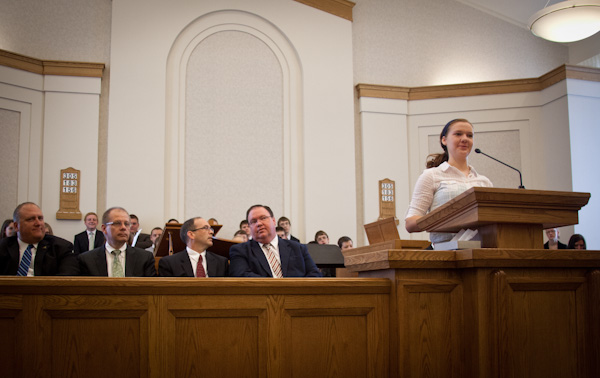SALT LAKE CITY (RNS) As Americans cast their ballots and the clock ticks toward midnight in Mitt Romney’s quest for the White House, this much is clear: Americans didn’t know much about Romney's Mormon faith when this “Mormon moment” began.
Now, thousands of headlines, dozens of TV newscasts and one Tony-winning Broadway musical later, Americans still don’t know much about Latter-day Saints and their beliefs.
But they know more. All those stories educated millions of observant Americans about the Church of Jesus Christ of Latter-day Saints. Still, some “understandings” remain misunderstandings — and many views of the religion continue to be skewed, exaggerated or flat-out wrong.
Here are 12 persistent myths about Mormonism:
1. Mormons practice polygamy
The LDS church officially gave up polygamy in 1890, when then-President Wilford Woodruff issued a “Manifesto” advising all members not to enter into “any marriage forbidden by the law of the land.”
Not all Latter-day Saints complied, so then-President Joseph F. Smith issued a “Second Manifesto” in 1904. Since then, any member practicing or openly advocating polygamy is excommunicated.
Groups that continue plural marriage — such as the breakaway Fundamentalist Church of Jesus Christ of Latter-Day Saints — do so outside the 14 million-member Utah-based faith.
Even so, Mormon scriptures describing and defending the practice remain part of the mainline LDS canon. Plus, men can be “sealed,” or married for eternity (Mormonism’s crowning rite), to more than one woman, while a woman can be sealed to only one man.
2. Mormons are not Christians
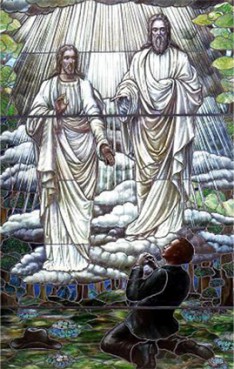
Mormons believe Joseph Smith received personal revelations from Jesus Christ and God the Father — two separate beings in Mormon theology — as seen in this stained glass window.
LDS theology does differ from historic Christians in key teachings — including the nature of God and his relationship to Jesus Christ, revelation and scripture. Traditional Christians believe in the Trinity — that God, Jesus and the Holy Spirit are one substance. Mormons believe God the Father, Jesus and the Holy Spirit are separate beings. Historic Christians heed the Bible as the sole word of God, while Latter-day Saints believe in the Bible and other scriptures, including the Book of Mormon. Still, Jesus Christ is the center of Mormon devotion, belief and practice. He is considered the Son of God and savior of all humanity.
3. Mormons aren’t supposed to drink caffeinated beverages
The LDS church’s health code, known as the Word of Wisdom, was issued in 1833 by Mormon founder Joseph Smith. It condemns alcohol, tobacco and “hot drinks,” which church leaders have subsequently described only as “coffee and tea.”
They say nothing about reasons for singling out those two drinks. Many members have presumed it’s because they contain caffeine and thus eschewed any beverages — especially carbonated sodas — containing caffeine.
The LDS church recently reiterated its longtime position that the only prohibited drinks were alcohol, coffee and tea. That left church-owned Brigham Young University having to explain why it did not serve or sell caffeinated colas. “There’s no customer demand,” school spokeswoman Carri Jenkins said. BYU students then launched a petition drive to exhibit the demand.
4. Mormons don’t dance
This falls in the “Mormons are like the Amish” misconception. Wrong. Dancing is fine. It’s a long-standing pleasure for the more faithful dating back to Joseph Smith and Brigham Young.
5. All Mormons live in Utah
The Beehive State is indeed densely populated with Mormons (62 percent), as are some neighboring states. Still, Latter-day Saints are spread across the U.S. in small pockets of believers and congregations. Members also live in more than 100 countries, and their numbers are increasing rapidly in Latin America and Africa. In fact, there are more Mormons outside the U.S. (8.2 million) than in it (6.2 million).
6. Women can’t be leaders or speak in the LDS church
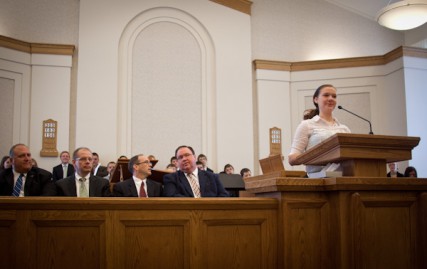
Kaitlyn Weeks speaks during the service at The Church of Jesus Christ of Latter-day Saints – Lenexa Ward on Sunday June 17, 2012 in Lenexa, Kan.
While it is true that the church’s lay priesthood is restricted to males 12 and older, Mormon women lead the women’s, young women’s and children’s organizations, teach scripture study and other classes, pray in services and preach from the pulpit. They can also be missionaries.
7. All Mormons are Republicans
Well, most are, so it may seem that way to left-leaning Latter-day Saints.
Nearly 60 percent of Mormons nationwide identify themselves as Republicans, compared with 14 percent who say they prefer Democrats, according to a 2011 report by researchers from Trinity College in Connecticut.
Mitt Romney, the first Mormon from a major political party to be nominated for president, is a Republican. But the highest-ranking elected Latter-day Saint is a Nevada Democrat, Senate Majority Leader Harry Reid. As an institution, the LDS church trumpets a strict policy of neutrality in partisan politics.
8. A Mormon U.S. president would be a puppet of the LDS prophet
Mormon scripture addresses this issue directly. Doctrine and Covenants Section 134, adopted by the church in 1835, says Mormons “do not believe it just to mingle religious influence with civil government.”
In a modern-day statement on political neutrality, the church says it does “reserve the right as an institution to address, in a nonpartisan way, issues that it believes have significant community or moral consequences or that directly affect the interests of the church.” Think the Equal Rights Amendment, California's Proposition 8, gambling, alcohol and immigration.
“Elected officials who are Latter-day Saints make their own decisions,” says the neutrality document, “and may not necessarily be in agreement with one another or even with a publicly stated church position. … These officials still must make their own choices based on their best judgment and with consideration of the constituencies whom they were elected to represent.”
9. Mormons baptize corpses
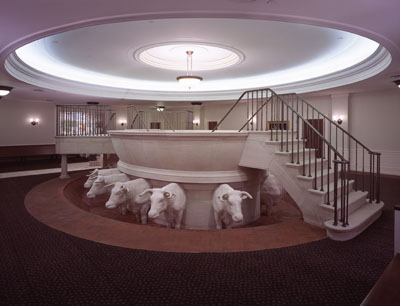
(RNS1-MAY20) The baptistry in the new Mormon Temple in Nauvoo, Ill., features 12 oxen
representing the 12 tribes of Israel. The Temple is a recreation of the original temple which was
destroyed in 1848 by fire and a tornado. See RNS-NAUVOO-TEMPLE, transmitted May 20.
Photo courtesy of Church of Jesus Christ of Latter-day Saints.
The LDS church does not use dead bodies, but it does have living volunteers do proxy baptisms for their deceased ancestors.
This ritual, known as “baptism for the dead,” is performed in much the same way as it is for the living, except proxy ordinances are done only in Mormon temples. A white-clothed candidate, standing in a font of water about waist-high, represents the dead person. He or she is then immersed after the adult male baptizer (also wearing white) says these words: “Having been commissioned of Jesus Christ, I baptize you for and in behalf of (name of the deceased) in the name of the Father, and of the Son, and of the Holy Ghost. Amen.” These are the same words that are said for a living baptism, without the words “for and in behalf of.”
A proxy baptism doesn’t mean that a person is automatically a Mormon in heaven. Latter-day Saints believe those who have passed on can choose to accept or reject the rite done in their names.
10. Mormons can’t use birth control
LDS families have more children than the average American, but it’s not because birth control is forbidden. The church teaches that having children is “the privilege of married couples,” but the decision on how many to have or how to space them, according to the faith’s Handbook for its leaders, “is extremely intimate and private and should be left between the couple and the Lord.”
The church also teaches that sex is about more than having kids. “Sexual relations within marriage,” says the Handbook, “are divinely approved not only for the purpose of procreation, but also as a way of expressing love and strengthening emotional and spiritual bonds between husband and wife.”
11. Mormons get naked in the temple
LDS temple rituals are not open to the public, which is why there is much fantasy and exaggeration about what happens inside. Members dressed mostly in white participate in a ritual re-enactment of the creation, Adam and Eve’s expulsion from the Garden of Eden, mortal experiences of the world and the return to God’s presence. At each stage of this progression, participants make promises to God. It is also a place where Mormon couples are “sealed,” or married, for eternity.
12. Mormons don’t believe in the Bible
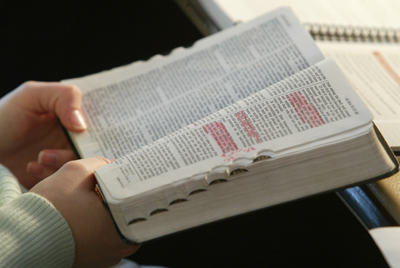
(RNS3-MARCH03) Sister Brown studies the Book of Mormon. See RNS-MORMON-WOMEN,
transmitted March 3, 2005. Photo by Julia Malakie.
The Bible, particularly the King James Version, is part of Mormon canonized scripture, along with the Book of Mormon, the Doctrine and Covenants and the Pearl of Great Price. The Bible is used in classroom discussions, quoted in sermons and is essential to missionary outreach. An LDS tenet holds that Latter-day Saints “believe the Bible to be the word of God as far as it is translated correctly.”
Sources: Encyclopedia of Mormonism, LDSnewsroom.org, LDS Church Handbook
(Peggy Fletcher Stack writes for The Salt Lake Tribune.)
KRE/AMB END STACK
